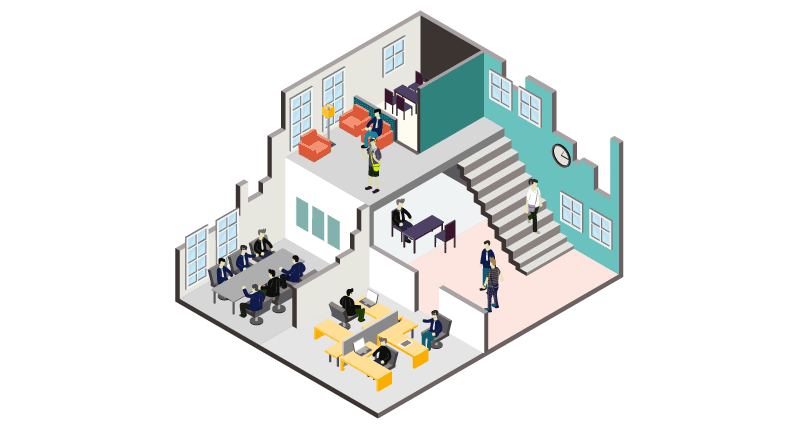Here’s a disconcerting statistic: 45% of employees do not have access to the right workspace at the right time. What does that mean? Well, you’ve got some people taking calls in open workspaces and disturbing those around them, others piling into cramped private offices to take conference calls, and even senior-level executives being forced to leave the office for important client meetings. And while you can never seem to locate an open conference room when you need one, studies show that meeting rooms are left vacant almost 50% of the time, costing the average organization in the U.S. $15 million every year in unutilized space. On top of that, the average employee spends a staggering 27 hours each year looking for the best space to work—costing the average company $31 million in lost productivity annually.
Needless to say, all these scenarios have a negative effect on both productivity and employee satisfaction...not to mention a company’s bottom line. In lieu of picking up and moving office buildings, there are several things tenants can do to make their existing spaces better suit their needs. Here are a few ways that implementing smart building solutions can help companies make the most out of a space.

Make underutilized spaces smart
Does your office have that one conference room that everyone avoids because it's always too hot? Or, maybe you hate it because it consistently takes you 20 minutes to figure out how to get a presentation up? Most offices have certain spaces that are undesirable, chronically underutilized, or outright avoided. Smart building solutions can make underutilized spaces go from drab to fab.
Smart AV Tech:
One of the biggest reasons people avoid certain conference rooms or office spaces is due to substandard technology. In fact, nearly 51% of surveyed IT professionals said that meeting space systems are too complicated and difficult to use. In contrast, smart meeting room technology is intuitive for all users. Wireless technology connects immediately to new or existing displays, projectors, or interactive whiteboards—no cables needed. With a few clicks of a touchscreen dashboard, even the most tech-challenged employee could switch from presentation mode to an in-person meeting to a conference call, or even a cat video (for some comic relief).
Temperature Control:
We’ve all been in meetings with too many warm bodies where the air—and subsequently, the conversation—gets stale. Office spaces that are too stuffy or over air conditioned are more than just uncomfortable, they take attention away from the important task at hand. Software solutions, like Comfy, that give occupants more control over the temperature in a given space can drastically improve productivity in an otherwise uncomfortable and undesirable space.
Lighting & Shading Control:
Lighting has received a lot of coverage recently, and for good reason: studies have shown that workplaces with enhanced lighting can improve productivity by up to 23%. That’s huge! However, lighting, like temperature, is not binary. Whether it's natural or artificial, the appropriate amount of light for a space changes based on the individual, the use case, and the time of day. The ability to fine-tune the quality of light in a space means that it is fully functional no matter the time of day.
Facilitate more effective sharing of current spaces
Conference Room Booking Systems:
The average annual cost of a meeting room in a large city is $20,000. At 50% utilization, that’s $10,000 wasted every year. One of the best ways to improve utilization of this highly valuable asset is to invest in software that allows occupants to select and resupply rooms as needed. Smart conference room booking systems empower employees to reserve rooms based on the precise requirements of the activity and reallocate "zombie" meetings that should have been canceled but were never removed from the calendar.
Hot Desking:
Hot desking has also gained traction as a way to give people access to the optimal workstation for their ever-evolving needs. While hot desking software allows people to find and select a more desirable work space, it can also provide key insights into how different types of workstations are being used and make adjustments based on those patterns. For instance, if 100% of the standing workstations are booked throughout the day as opposed to 40% of traditional desks, perhaps there is a good argument for reallocating space.
Obtain better insight for future space planning
Beacons:
Beacons are low-cost transmitters generally using Bluetooth Low Energy (BLE) connections to obtain location and context-aware data. Beacons can be used to pinpoint the location of smartphones and, as a result, the people to which they are constantly attached. Beacons have the ability to provide more granular data than sensors alone, particularly when it comes to space utilization and answering the questions who, where, and when. Beacons allow corporate real estate teams to understand the diversity of how spaces are being used, whether there are many people flowing in and out over different times of day or the same person occupying a space. With this knowledge, workplace designers can plan spaces to alleviate overcrowding in quiet zones or create "intentional congestion" to encourage cross-team collaboration. With more insight comes the opportunity to better optimize and reallocate space based on known usage patterns...enhanced space utilization for the win!
________________
Whether you’re a Fortune 1000 company with a large real estate portfolio or a small startup, tools that improve space utilization can have significant payoff. Providing access to the space people need, when they need it, improves both employee productivity and satisfaction while getting more bang for your corporate-budget buck. With the rise of flexible work environments and smart building tech, employers now have much, more ammunition to improve utilization and optimize use of a given space without breaking walls…or the bank.
Want more? Subscribe to follow along and get social with #AtoZSmartBldgs.

